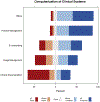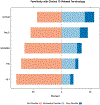Adoption of electronic health records and preparations for demonstrating meaningful use: an American Academy of Ophthalmology survey
- PMID: 23806425
- PMCID: PMC12312035
- DOI: 10.1016/j.ophtha.2013.04.029
Adoption of electronic health records and preparations for demonstrating meaningful use: an American Academy of Ophthalmology survey
Abstract
Objective: To assess the current state of electronic health record (EHR) use by ophthalmologists, including adoption rate, user satisfaction, functionality, benefits, barriers, and knowledge of meaningful use criteria.
Design: Population-based, cross-sectional study.
Participants: A total of 492 members of the American Academy of Ophthalmology (AAO).
Methods: A random sample of 1500 AAO members were selected on the basis of their practice location and solicited to participate in a study of EHR use, practice management, and image management system use. Participants completed the survey via the Internet, phone, or fax. The survey included questions about the adoption of EHRs, available functionality, benefits, barriers, satisfaction, and understanding of meaningful use criteria and health information technology concepts.
Main outcome measures: Current adoption rate of EHRs, user satisfaction, benefits and barriers, and availability of EHR functionality.
Results: Overall, 32% of the practices surveyed had already implemented an EHR, 15% had implemented an EHR for some of their physicians or were in the process of implementation, and another 31% had plans to do so within 2 years. Among those with an EHR in their practice, 49% were satisfied or extremely satisfied with their system, 42% reported increased or stable overall productivity, 19% reported decreased or stable overall costs, and 55% would recommend an EHR to a fellow ophthalmologist. For those with an electronic image management system, only 15% had all devices integrated, 33% had images directly uploaded into their system, and 12% had electronic association of patient demographics with the image.
Conclusions: The adoption of EHRs by ophthalmology practices more than doubled from 2007 to 2011. The satisfaction of ophthalmologists with their EHR and their perception of beneficial effects on productivity and costs were all lower in 2011 than in 2007. Knowledge about meaningful use is high, but the percentage of physicians actually receiving incentive payments is relatively low. Given the importance of imaging in ophthalmology, the shortcomings in current image management systems need to be addressed.
Financial disclosure(s): The author(s) have no proprietary or commercial interest in any materials discussed in this article.
Copyright © 2013 American Academy of Ophthalmology. Published by Elsevier Inc. All rights reserved.
Figures






References
-
- Boland MV. Meaningful use of electronic health records in ophthalmology. Ophthalmology 2010;117:2239–40. - PubMed
-
- Centers for Medicare and Medicaid Services. September 2012 EHR incentive program active registrations. Available at: https://www.cms.gov/Regulations-and-Guidance/Legislation/EHRIncentivePro.... Accessed November 7, 2012.
-
- Chaudhry B, Wang J, Wu S, et al. Systematic review: impact of health information technology on quality, efficiency, and costs of medical care. Ann Intern Med 2006;144:742–52. - PubMed
-
- Goldzweig CL, Towfigh A, Maglione M, et al. Costs and benefits of health information technology: new trends from the literature. Health Aff (Millwood) 2009;28:w282–93. - PubMed
-
- Buntin MB, Burke MF, Hoaglin MC, et al. The benefits of health information technology: a review of the recent literature shows predominantly positive results. Health Aff (Millwood) 2011;30:464–71. - PubMed
Publication types
MeSH terms
Grants and funding
LinkOut - more resources
Full Text Sources
Other Literature Sources

